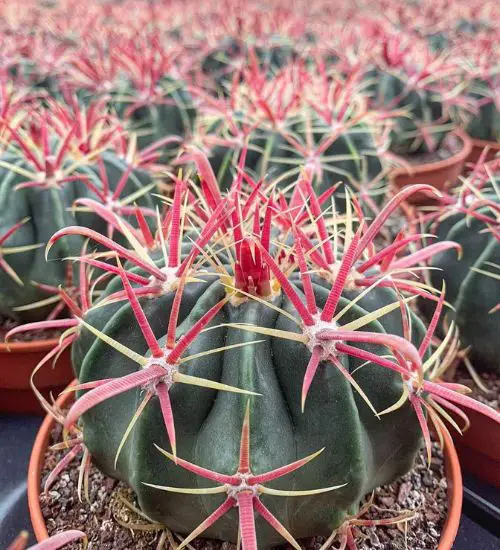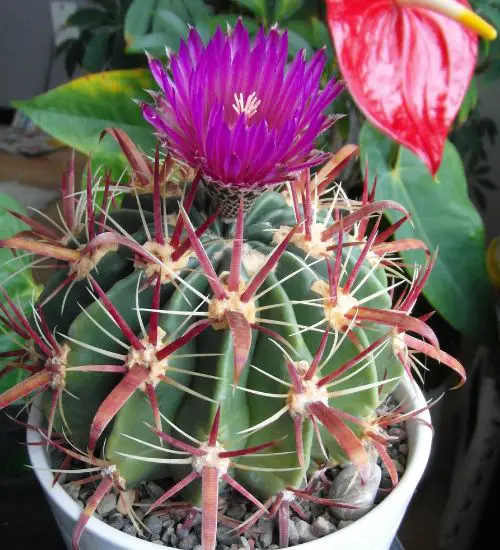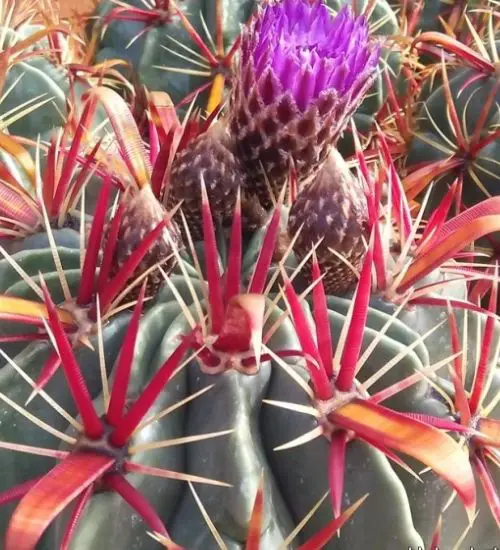Sun: full sun
Water: Below average watering needs for a succulent
Temperature: Zone 9b from 25° F to 30° F (-3.9° C to -1.1° C)
Winter Survival: Not cold hardy
Propagation: seeds
Flower: in fall or early winter
Flower Type: purple
Toxic: Generally non-toxic to humans and animals
Dormant: winter
Space Requirement: Outdoors
Common Problems: pests
Where to buy Ferocactus Latispinus?
Basc Care for Ferocactus Latispinus
Watering
Watering for Ferocactus Latispinus is a simple task. It requires Below average watering needs for a succulent.
Regular watering period should be every 2 weeks
Fertilizing
Only feed this succulent during its active growing seasons which means winter. Use the right fertilizer applied in the right amounts. Applying half-strength balanced fertilizer every month or so is recommended for optimal results.
Do not fertilize during winter as the plant is dormant.
Sun & Location Requirements for "Candy cactus, Devil’s Tongue Barrel, Crow’s Claw Cactus"
Ferocactus Latispinus requires full sun for optimal growth and health. Place your succulent in a sunny spot in your garden or on a windowsill to ensure it's getting enough light. You'll know that the succulent is receiving enough sunlight if its leaves are bright green and firm.
As per this succulent profile, it is only able to stay healthy when the environment temperature is above the range of zone 9b from 25° F to 30° F (-3.9° C to -1.1° C).
When temperatures drop below freezing, it is important to take precautions to protect Ferocactus Latispinus from the cold. Insulating and providing adequate drainage for the plant are key elements in helping it survive winter weather. Wind and sun exposure should also be minimized to prevent frost damage.
Any succulents in the group will need a large space to grow. You should place your pot outdoor. Since this plant needs a lot of space than other succulents, you should consider not planting them together with other succulents/plants.
Propagation
Propagating Ferocactus Latispinus from seeds is a great way to produce new plants without relying on cuttings or divisions. It's important to look for healthy, dark and plump seeds that are slightly sticky when touched. The soil should be pre-mixed with well-draining potting mix, before evenly sowing the seeds and pressing them into the surface. To ensure successful germination, gentle misting of the soil should be done and placed in indirect light.
Toxicity

Ferocactus Latispinus is not known to pose any significant health risks, as it is not considered to be toxic. However, it is best to keep the plant away from young children and pets, as they may ingest some of the parts of this plant that could contain toxins which can cause mild skin irritation.
Pests and Diseases
Ferocactus Latispinus can be affected common pests and diseases like most of the other succulents such as Red spider mites.
If you do spot any of pest signs, you can treat your succulent using below methods.
- Red spider mites: Quarantine, clean your infected plants, treatment with a systemic insecticidal/soapy water.
Besides that, to prevent serious health issues from happening, keep your succulent in a well-ventilated area and check it regularly for any signs of pests or health problems.


